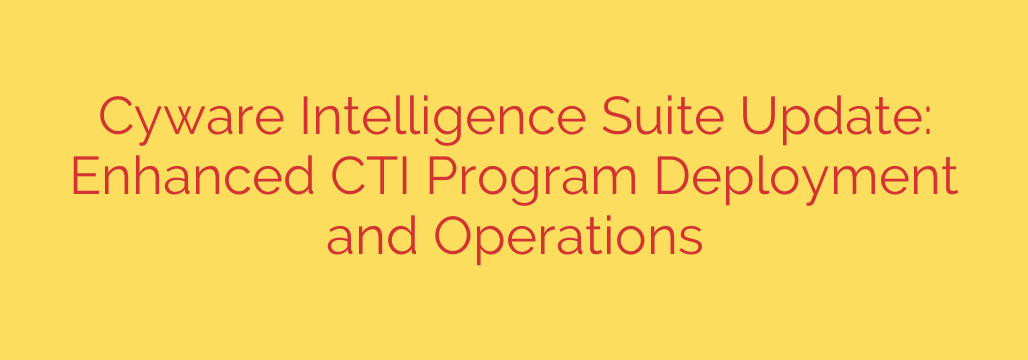
From Data to Defense: How to Build and Optimize Your Cyber Threat Intelligence Program
In today’s complex threat landscape, a robust Cyber Threat Intelligence (CTI) program is no longer a luxury—it’s a necessity. However, many organizations struggle to move beyond simple data collection. They find themselves drowning in threat feeds, facing analysis paralysis, and failing to translate raw data into decisive action. The result is a CTI program that is costly, inefficient, and reactive.
The core challenge is that building an effective CTI program from the ground up is traditionally a slow and resource-intensive process. It requires deep expertise to define intelligence goals, connect disparate data sources, and manually build workflows.
Fortunately, the approach to CTI is evolving. Modern strategies and platforms are making it easier than ever to deploy and manage a high-impact intelligence program that actively strengthens your security posture. Here’s how you can build a CTI program that delivers real, measurable value.
Step 1: Establish a Guided and Strategic Foundation
The success of any intelligence operation hinges on a clear mission. Instead of simply aggregating data, you must start by defining what you need to protect and what you need to know.
Define Your Intelligence Requirements: A successful program begins with clearly defined Priority Intelligence Requirements (PIRs). What are the most critical threats to your organization? What are your most valuable assets (your “crown jewels”)? Answering these questions focuses your efforts and ensures you collect data that is directly relevant to your business risks.
Map Threats to Your Infrastructure: Connect your intelligence requirements to your specific technology stack, industry, and geographical footprint. A modern approach involves a guided setup process that helps you select the right threat feeds and data sources that align with your unique operational environment.
Select and Validate Sources: Not all threat intelligence is created equal. Your program should prioritize high-quality, relevant sources, including open-source (OSINT), commercial feeds, and information from sharing communities like ISACs and ISAOs. The initial setup should focus on sources that directly address your PIRs.
Step 2: Automate the Intelligence Lifecycle for Speed and Scale
Manual analysis is the biggest bottleneck in most security operations centers (SOCs). To keep pace with attackers, you must automate the entire threat intelligence lifecycle—from collection and enrichment to analysis and dissemination.
This means implementing a system that can automatically:
- Ingest and Normalize Data: Pull in threat data from all your sources in various formats.
- Enrich with Context: Add crucial context by correlating data with indicators of compromise (IOCs), adversary tactics, techniques, and procedures (TTPs), and vulnerability information.
- Analyze and Score Threats: Use machine learning and AI-driven analysis to automatically score threats based on relevance, severity, and confidence, separating the signal from the noise.
A key element of modern CTI is the use of pre-built security use cases. These are packaged workflows designed to address specific, high-priority threats like ransomware, phishing, or brand impersonation. By leveraging these templates, security teams can immediately operationalize intelligence for common challenges without having to build complex processes from scratch.
Step 3: Continuously Monitor the Health of Your CTI Program
How do you know if your CTI program is actually working? You can’t improve what you can’t measure. It is essential to continuously monitor its health and effectiveness through a dedicated dashboard or reporting system.
Key performance indicators (KPIs) to track include:
- Source Effectiveness: Which threat feeds are providing the most valuable and unique intelligence?
- Data Enrichment: Is your data being properly contextualized?
- Alert Fidelity: Are you reducing false positives and empowering analysts with high-confidence alerts?
- Intelligence Sharing: Is critical information being shared effectively with internal teams and external partners?
- Contribution to Defense: Can you measure a reduction in Mean Time to Detect (MTTD) and Mean Time to Respond (MTTR) as a result of your CTI efforts?
Monitoring these metrics provides a clear picture of your CTI program’s ROI and helps you make data-driven decisions to fine-tune your strategy over time.
Actionable Advice for a Stronger Security Posture
Building an effective CTI program is a journey, not a destination. Here are a few key tips to keep in mind:
Focus on Actionable Intelligence: The ultimate goal is not to collect data but to drive action. Every piece of intelligence should be triaged and routed to the right tool or team—whether it’s sending IOCs to a firewall, updating SIEM watchlists, or initiating a SOAR playbook.
Align CTI with Business Objectives: Ensure your security leaders can clearly articulate how the CTI program reduces specific business risks. This alignment is crucial for securing ongoing budget and executive support.
Empower Your Analysts, Don’t Replace Them: Automation should handle the repetitive, low-level tasks, freeing up your human analysts to focus on strategic activities like threat hunting, adversary tracking, and strategic reporting.
By adopting a structured, automated, and measurable approach, organizations can transform their CTI program from a passive data repository into the proactive, intelligence-driven core of their entire security ecosystem.
Source: https://www.helpnetsecurity.com/2025/07/29/cyware-intelligence-suite/








